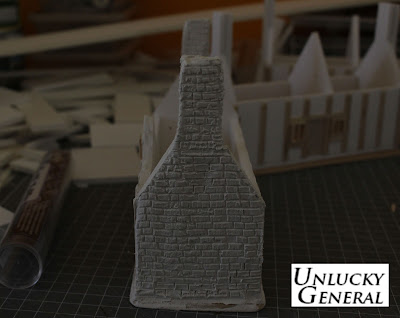Minature Builder's Yard: ECW Houses Part 1
Some might say this is yet another distraction from my persistent list of major projects. In my defence, I'm recovering from retinal surgery with a month off work. It's only over the past three days I have recovered full vision in my left eye - sufficient to work on terrain but it's too much of a strain for figure painting.
I don't know if you can relate to this but whilst I was unable to do much other than one-eyed reading I had another moment of madness. What do you do when you can't build armies? Well, I tend to research, spin up new enthusiasms and end up buying new ones. My pile of potential is looking like the Great Pyramid.
My enduring fascination with the English Civil War (let's call it that) is a love now requited and as I wait for my orders to come in, I have started a series of new buildings. A few years back I bought all of Robert Giglio's ECW Campaign Scenario series and I am building armies to fight the 1643 campaign in the South-West between the forces commanded by Sir William Waller and Sir Ralph Hopton.
Flicking through this simply fantastic and comprehensive book, there is a series of superb perspective maps which include details such as the buildings present. I have divided them into small farm-houses, long farm-houses, stone cottages, town houses, public houses (inns), churches and mills. Once built, I will be able to populate all twelve scenario table-tops.
They are mostly timber frame dwellings with a combination of thatched and shingle roofs. I say they are 17th century dwellings but I'm certain they can serve from 16th century through to early 19th century - it's all about the chimneys.All are constructed with 5mm foam-core, 1mm balsa for the framing, 3mm balsa for the doors and DAS air drying clay (white ... obviously). When applying the DAS, I'm mixing PVA into it and wetting the surfaces before applying and also smearing some PVA across the whetted surfaces in preparation. So far, there's been no cracking and I'll continue with this technique - but it may not be necessary.
The brick texturing on the walls and chimneys is achieved with the aid of a Green Stuff World Dutch Bricks pattern roller (no: 1336) which is then tidied up with some sculpting tools. The double row of foundation brick is all etched in by hand. I'm looking forward to the roof thatching with will also be DAS which I will score. I have to observe that my skills and technique when it comes to working with DAS improved noticeably from the first to the last of these models. There really is no substitute for practise.
I have the first six buildings underway but I suspect I'll wrap it for the time being after that. I'm keen to finish my Mediterranean terrain boards (the last six) and by next week I'll get my head back to the magnifying lamp and push on with my figure painting. More on this build soon.








Comments
Post a Comment